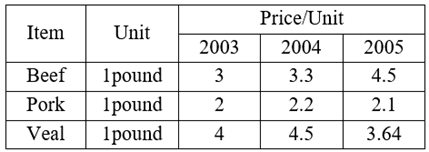098. A Simple Price Index
A simple price index characterizes the relationship between the price of a good or service at one point in time, called the Base period, to the price of that same good or service at a different point in time, called the Reference period.
To calculate a simple index, you merely divide the price of the commodity in the reference period by its price in the base period and multiply by 100.
Example 9.1. Determine the price index for the reference period 2003 and chose 2008 as the base period. Thus,
 (9.1)
(9.1)
PI2003=
Where PI is the price index and P is the price in the respective years.
Example 9.2. Jack Nipp and his partner, Harry Tuck, own a meat packing plant in Duluth. Data for their three most popular items are shown in Table 9.1.
Table 9.1 – Data for Nip and Tuck, Inc.

Nipp tells Tuck to compute a simple price index for each product with 2003 as the base period. Using Formula (9.1), Tuck finds that the price indexes for beef in each of the three years are



From the base year of 2003 to 2004, the price index rose from 100 to 110. Tuck can therefore conclude that the price of beef increased by 10 percent. This is calculated as the difference between the two index numbers divided by the base number. That is,

Similarly, it can be concluded that a 50 percent increase occurred from 2003 to 2005:

You might want to conclude that a 40 percent increase in price occurred from 2004 to 2005 since the price index increased by 40. However, this is not the case. The percentage increase from 2004 to 2005 is

The 40 percent difference between the index numbers in 2004 and 2005 is called the Percentage point increase, not the percentage increase.
Notice that the price index in the base year is always 100. This will always be the case since the price in the base year is, of course, 100 percent of itself.
The indexes for pork and veal are calculated in similar fashion and are shown in Table 9.2. Notice that the 2005 index for veal is less than 100. This reflects the fact that veal prices in 2005 were lower than they were in the base year of 2003. Specifically, prices for veal went down by (100 — 91)/100 = 9 percent from 2003 to 2005.
Table 9.2 – Price Indexes for Nipp and Tuck, Inc. (2003=100)
|
Item |
2003 |
2004 |
2005 |
|
Beef |
|
|
|
|
Pork |
|
|
|
|
Veal |
|
|
|
| < Предыдущая | Следующая > |
|---|